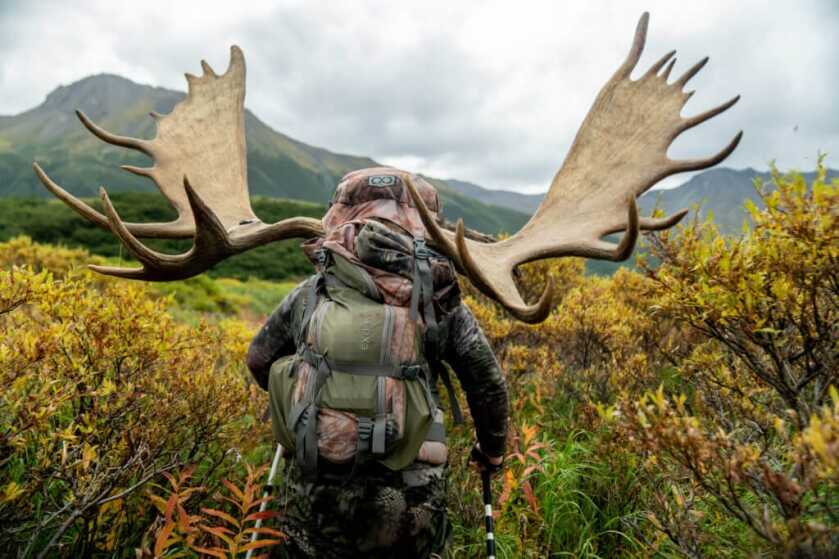
The Super Cub floated and bumped along a couple thousand feet over white caps on the lake below. Wind drove clouds through the high passes of the mountain range to our right, with the peaks covered in fresh snow. The Cub yawed left with the quartering winds as we turned up a valley into a cleaner headwind. A sow brown bear with two cubs lunged across a gravel bar as if in slow motion before crashing into the water after spawning sockeye salmon. Farther up the valley I could see a small ridge running parallel with the barricade of peaks thousands of feet higher on each side. We swung around and settled into a shallow glide slope to land next to that ridge in a short and somewhat crooked airstrip cut into the willows and alders. One airplane width to the left and we crash into the ridge, to the right and we are in the brush, but everything looked good to me as I peaked over the pilot’s shoulder from the back seat. As our air speed drained and the plane descended, a gust of wind came over the top of the ridge and hit the airplane on top of its wings and we dropped into the brush just short of the strip. The big bush wheels blew through the brush and we popped out onto the strip and taxied the few short yards to where my guide, Cole Kramer, was repairing a broken tent pole with a piece of alder he had whittled down using the chopper he’d had built at Grizzly Forge. After five days of travel since leaving my home in Oregon, I was at moose camp.
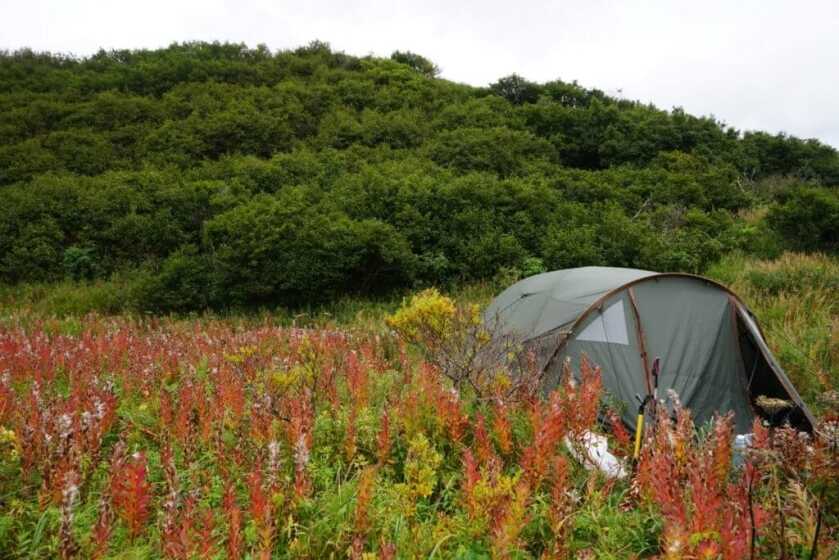
Hunting Alaska is a massive logistic challenge. The expanse of the place is hard to understand. If one were to drive from the Salty Dawg Saloon on the Homer spit to a less famous bar in Prudhoe Bay on the north shore of the state, that would take 21 hours, without stops. Most of the state simply does not have roads. Jet boat trips for moose up the Yukon river commonly go over 800 miles, one way. Bush planes with huge tundra tires or floats are a common mode of transport and pilots have pushed the envelope to the edge and beyond, learning where they can land and take off, and the lessons are written in twisted aluminum wreckage on mountains and lakes and tundra throughout the state.

I started in NE Oregon and drove to a hotel near a regional airport four hours away in Washington state to spend the night. Commercial flights which take off early in the morning are less likely to get delayed and therefore are more likely to deliver you AND your baggage to the destination on time. The next morning before sunrise I was eagerly sitting on the plane and bouncing around airports until finally landing at Anchorage where I would meet the rest of our team. We spent the night there, transferred rifles into soft cases, and loaded out hunting packs so we’d be ready to go at a moment’s notice. A weather check at 0600 the next morning looked positive so we convoyed with Ubers and taxis to another small airport where we weighed in ourselves and our gear. The destination was a remote portion of the Alaska peninsula, which is the long curving volcanic arm extending into the Aleutian Islands towards Russia. With the Bering Sea above and the North Pacific below, the thin peninsula of jagged peaks is among the most volatile weather locations in the world.
Mr John Brasseur from Sig Sauer, some of the guide staff, our camera crew from Idarado, and myself boarded a King Air packed tight with our gear and groceries for the village we were flying into and took off headed West. The flight was IFR with zero visibility and before long the windshield iced over and the wings started to change colors as ice built on the leading edge. The pilot seemed unbothered and we flew along until during our descent a cliff appeared off our left wing then about 800’ above the ground we saw a short dirt runway and with the engines in reverse thrust we hit the ground and rolled to a stop next to some barrels of fuel.
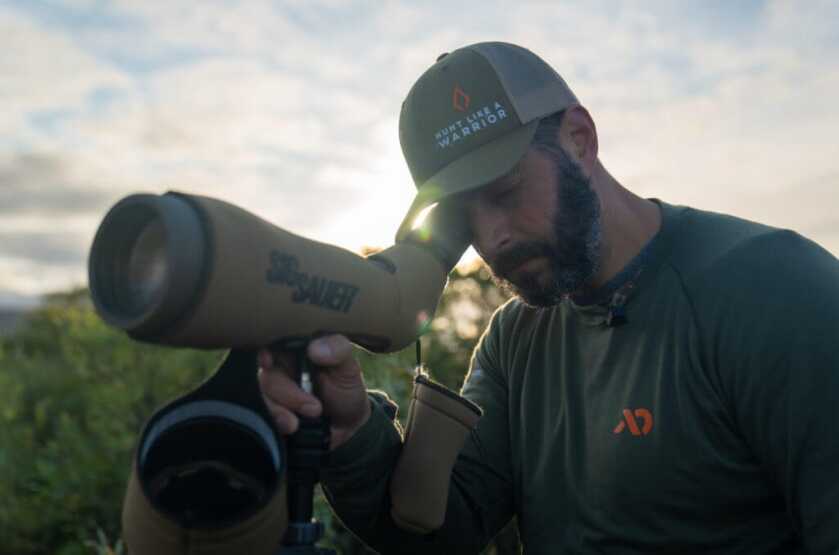
We ended up in this village of around 50 people for a couple more days of weather that didn’t allow us to take the Super Cubs into the bush where we intended to hunt. The Super Cub is a classic bush plane with a good payload of weight, the ability to take off and land on short strips and gravel bars, and excellent reliability. Inserting hunters into their camps means that the pilot plus one person and some gear fly in, land, unload and then fly back for another person and their gear. With the guide, packer, hunter and camera man that made for at least four trips per camp.
A hunter cannot hunt the same day they fly in Alaska. So, after I landed the tasks at hand were to setup the tents and organize camp. In an ideal weather situation, the guide would fly in first, followed by the packer, so that everything would be pretty well setup before by the time the hunter gets in. We could see our weather window closing as the winds picked up, and because I am much happier helping do things than to have them done for me I flew in before the packer. This turned out to be a smart decision because the weather got worse and no more flights were possible for another 36 hours. Cole and I had plenty to get by with what we had. I flew wearing the gear I’d want to have on if we crashed, and had my pack loaded out with everything I needed. I brought my rifle in a tough padded drag bag and had an extra scope with me which was sighted in and ready to go.
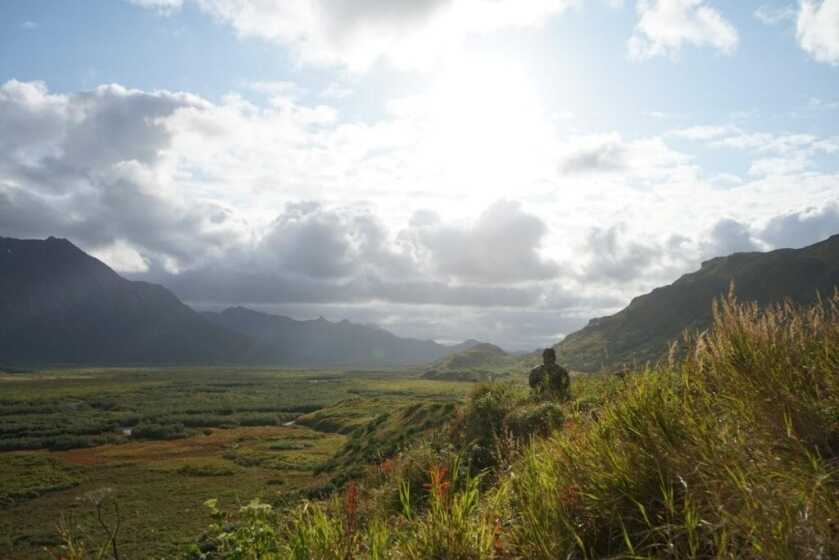
On major expedition hunts, if possible, I recommend bringing two scopes, if not two rifles. With good scope rings and a torque wrench, you can sight in and remove the scope from a rail and place it back on again and expect to be within an inch at 100 yards. The key to this is torquing the scope bases to the exact setting each time. I bring a small tool kit from fix-it-sticks which allows me to hit that suggested 65 inch/lb setting every time. My scope of choice for this hunt is the Sig 5-30 Tango6 with a DEV-L reticle. The scope is tough and reliable, has the ability to use the turrets or the reticle for ballistic solutions, and the optical clarity is fantastic from the first minute of legal shooting light to the last.
On our bad weather day, Cole and I hung out beneath a tarp and glassed the valley looking for moose. We found two or three bulls that were in that barely legal range and I literally lost count of the brown bears we saw in the high mountain basins and hunting salmon in the crick. Collecting water was a two-person job, with one guy looking and listening for bears while the other filled water. I drank it unfiltered, which isn’t the smart choice, but it hasn’t bit me yet.
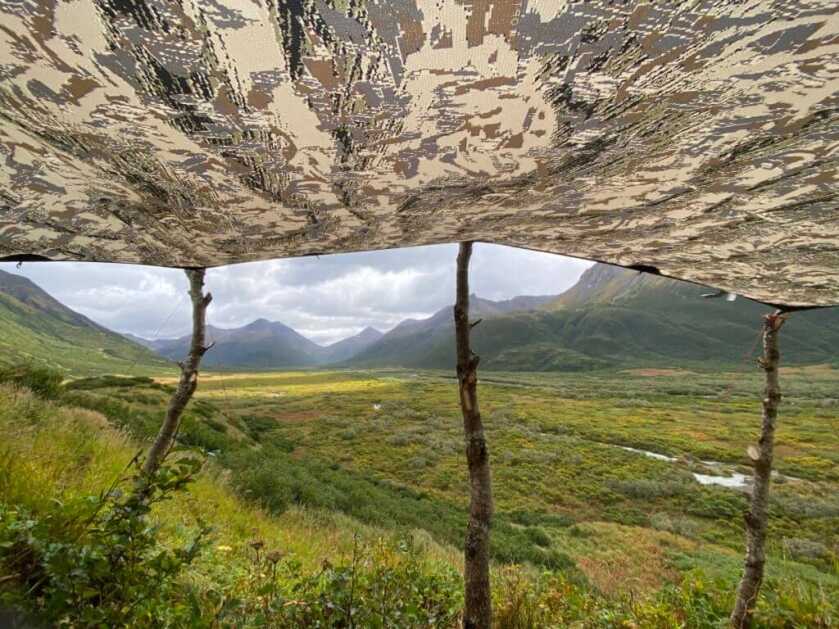
The next day gave us better weather and we were joined by packer Luke Gerig from Cheyenne, Wyoming and Max Benz from Idarado Media. I’ve worked with Max on a few projects before and he’s great to be around, extremely skillful and always kind. Luke is working towards becoming a guide, a 4-5 year process in Alaska, and impressed me with his enthusiasm, humility, and drive to achieve his dream.
Without wind, the bugs had their way with us. Just part of the game in Alaska. They aren’t going to kill you, but can definitely erode your sense of comfort and mental endurance. The bears seemed to have moved elsewhere for the day. We had one of the bulls from the previous day bedded 400 yards from our ridge and watched as another walked over a small rise towards the bedded bull. He covered the mile of willows and hummocks of tundra with the grace of a boat in the water. These moose stand over 7 feet tall at the shoulder and cover country faster than I realized was possible. When the bulls met, they started posturing and grunting, and walking parallel to each other with their heads dramatically tilting from side to side with each step. Giving each other the ugliest side-eye they could muster, one of the bulls turned to fight and the other kept posturing. The bull that offered to fight suddenly wheeled away and lost this display and contest of dominance. It was an incredible spectacle, and although I wanted to see an all-out brawl between two bulls of the largest deer species in the world, I was nevertheless fascinated by what I saw.
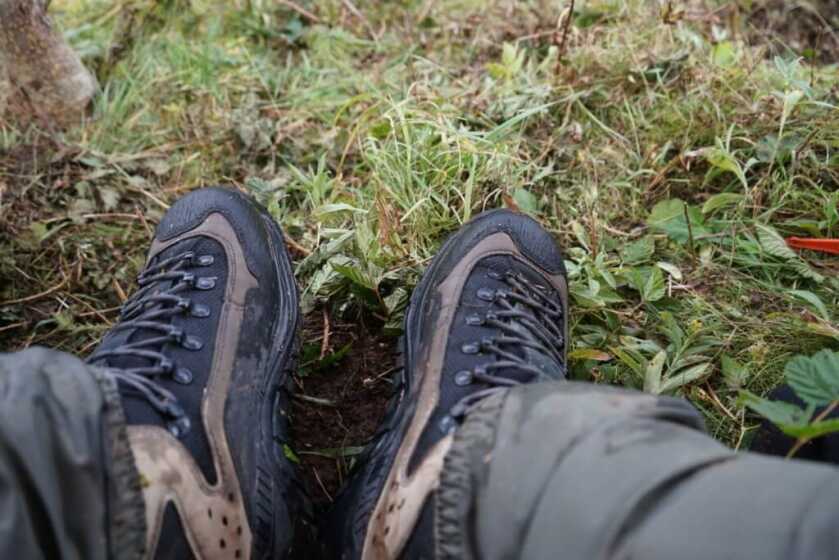
That night I heard brush moving outside the tent and tried to separate the soft snores of the men in camp from what I was sure was a bear, a moose, or potentially Sasquatch. I reached over the side of my cot for the reassurance of my Sig 1911 tac-ops 10mm and strained my ears for more clues as to what the sounds in the night came from before yelling “hey bear” and waking everyone else in camp. I heard nothing else, said nothing, and eventually went back to sleep.
The next morning I woke to the sound of propane being lit for a hot cup of black rifle coffee. I’d been sleeping in my waterproof down Kryptek 0 degree bag with my clothes on so the bag plus my body heat could dry everything out. It worked perfectly and made getting ready that much faster each day. I’d kept my rifle in the vestibule so it didn’t fog the scope from changing temperatures and slid it into the pocket on the side of my pack.
Cole was tidying up in the dark and said I could hike on up to the glassing knob since I was ready early. In the grey light of morning, I started scanning with my Zulu6 16x image-stabilized binoculars. There wasn’t anything to see yet besides the dim shapes of the mountains and the outline of the gravel bars of the creek. As colors began appearing, Max and Luke made it to the top of the hill. Jokingly, I asked Luke where we were going to kill a bull today. He pointed to the hard ground above the airstrip and said, “right there.” With a live weight of 1800lbs, moving moose is no joke and requires 8-12 heavy loads. I smiled at his optimism and resumed glassing.
Less than two minutes later I spotted a paddle sticking out go the willows. I crow called down the hill to Cole who was already on his way up. The bull appeared almost exactly where Luke had just pointed and started walking down towards the airstrip! I mounted my rifle on the big tripod I carry and wrapped the elastic cord of my shooting bag around my torso to create a more stable position for my right elbow. The two most transferrable skills from completion shooting to hunting I’ve adapted in recent years are high-quality tripods and shooting bags.
Cole set up his spotter next to me and started analyzing the bull’s tines, width, and paddles. He was way over legal and I was ready to shoot. The truth is that I get unreasonably excited in these moments and my judgment becomes questionable. I stayed on the rifle but kept my eye out of the scope, this was Cole’s moment to use his skill in estimation and judgment. After determining this was a shooter, Cole asked me if I liked the bull while keeping his eye in his spotter. I said yes and Cole looked at me and said, “you aren’t even looking through your scope.”

I’d been trying not to get too spun up about this giant animal and was operating under the theory that looking at him would make it worse. I looked through the scope again and softly repeated, “yes.” Later, I’d look at the stats from my Garmin watch and see my heart rate was in the 160’s.
I looked back to make sure Max was good to go, and Cole let out a short call to stop the bull and gave me the green light. My bullet smashed through his left shoulder and as the bull turned Cole said, “slip another one in there.” That shot took out the top of his heart. As he fell he disappeared into the willows. Max pointed his camera at me and asked what I was feeling and I said, “it’s too soon to talk about.” I was feeling everything, a lot, and all at once.

It took all four of us, cutting and packing, five hours to move the bull 200 yards to the strip. It was perfect. Once packed out, we called for the plane and started sending loads of meat out to the local villages whose land we were on, and who were grateful for the red meat. That night, Cole fried some tenderloin in butter with salt and pepper in the tent, bears be damned. The moose tasted like the place felt, wild and satisfying.

The same morning, John Brasseur killed a bull moose in his camp. With a less troublesome and reverse order, we began the trip home, this time it would only take three days.
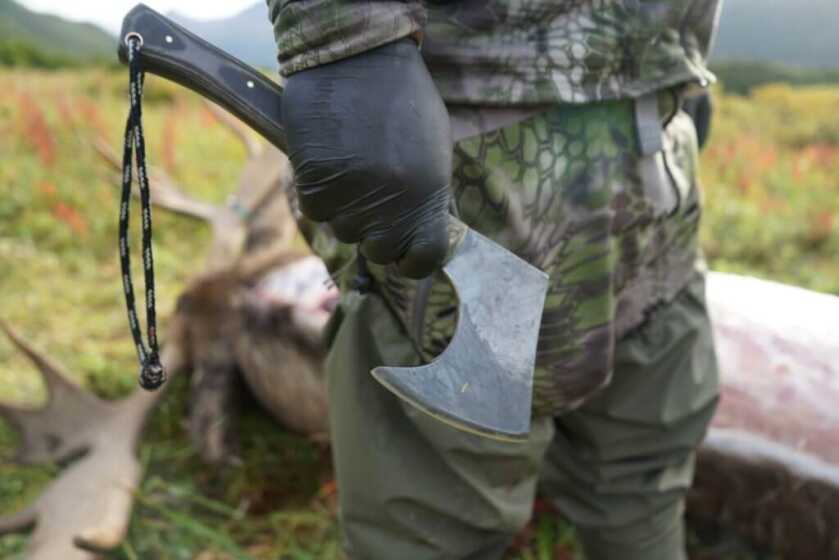

Something you may not know is that part of the testing process for Sig Sauer on new guns is to send them into the field under trying circumstances. This was our purpose. To use a prototype rifle against an incredibly tough animal in an unforgiving and difficult place. You simply cannot test a rifle in a lab in the ways it gets tested in the real world, by real hunters.
Alaska. The weather, distance between places, wildlife, people, and terrain are like no other place I’ve been. The logistics can be daunting. Noting comes easy, but every once in a while, it works out that a good bull shows himself on hard ground near the airstrip. All that’s left to do is all that matters.


Nice story,well written. Thank you.
Martin